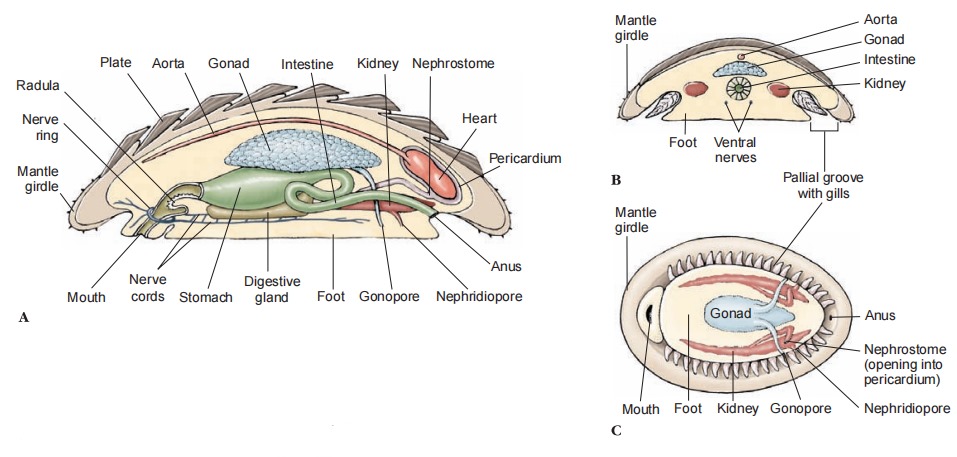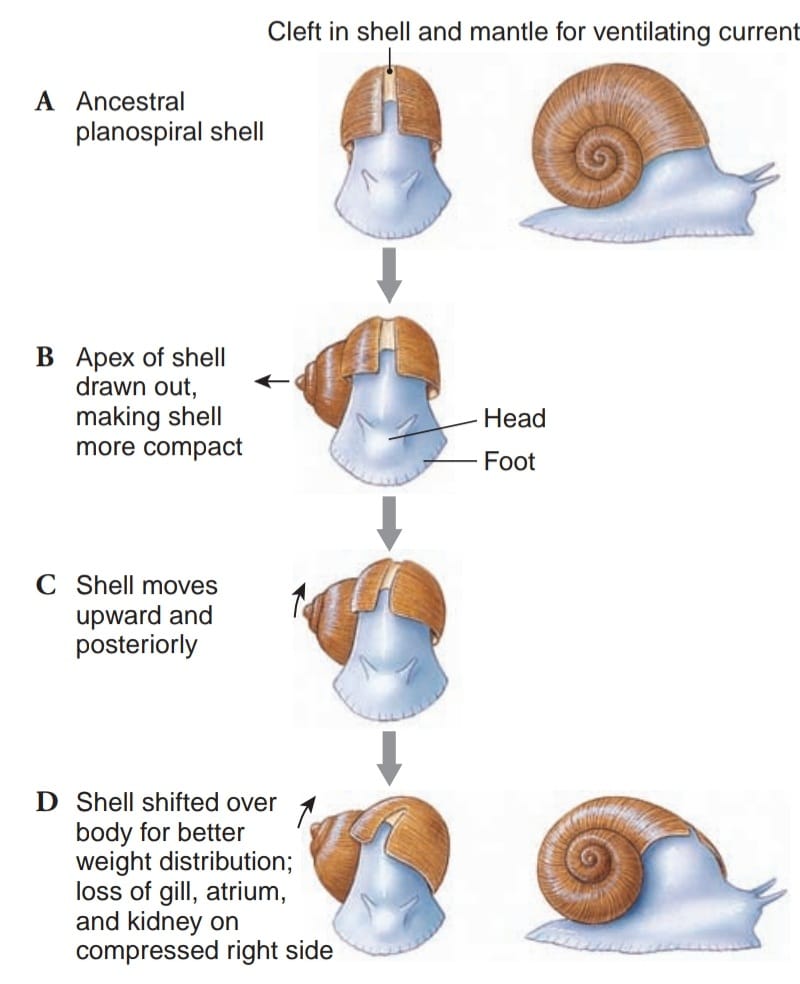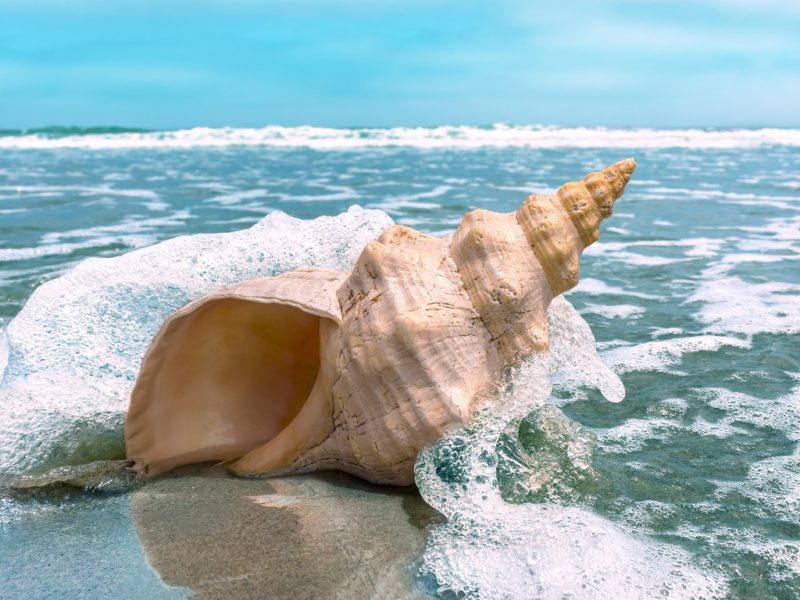Torsion Gastropod development varies with the particular group under discussion, but in general there is a trochophore larval stage followed by a veliger larval stage where the shell first forms. The veliger has two ciliated velar lobes, used in swimming, and the developing foot is visible. The mouth is anterior and the anus is posterior initially, but the relative positions of the shell, digestive tract and anus, nerves that lie along both sides of the digestive tract, and the mantle cavity containing the gills, all change in a process called torsion.

Torsion is usually described as a two-step process. In the first step, an asymmetrical foot retractor muscle contracts and pulls the shell and enclosed viscera (containing organs of the body) 90 degrees counterclockwise, relative to the head. This movement brings the anus from the posterior to the right side of the body. Typical descriptions state that movement of the shell accompanies visceral movement, but recent detailed studies have shown that movement of the shell is independent of visceral movements.
The first movements of the shell rotate it between 90 and 180 degrees into a position that will persist into adulthood. It was previously assumed that the mantle cavity, which houses both the gills and the anus in adult animals, moved with the anus in the first 90 degrees of torsion. However, new studies have shown that the mantle cavity develops on the right side of the body near the anus, but is initially separate from it. The anus and mantle cavity usually move farther to the right and the mantle cavity is remodeled to encompass the anus. In a slower and more variable series of changes, the digestive tract moves both laterally and dorsally so that the anus lies above the head within the mantle cavity.
After torsion, the anus and mantle cavity open above the mouth and head. The left gill, kidney, and heart atrium are now on the right side, whereas the original right gill, kidney, and heart atrium are now on the left, and the nerve cords form a figure eight. Because of the space available in the mantle cavity, the animal’s sensitive head end can now be withdrawn into the protection of the shell, with the tougher foot, and when present the operculum, forming a barrier to the outside.
The developmental sequence just described is called ontogenetic torsion. Evolutionary torsion is the series of changes that produced the modern torted gastropod body from the ancestral untorted form. The hypothetical ancestral gastropod was assumed to have a posterior mantle cavity like the hypothetical ancestral mollusc . It has long been assumed that morphological changes in ontogenetic torsion represent the sequence of evolutionary changes. However, new studies of development in several kinds of gastropods suggest a different scenario; researchers hypothesize that the ancestral gastropod had two lateral mantle cavities, much like those in Neopilina.


A single mantle cavity over the head may have arisen when the left lateral mantle cavity was lost and the right cavity expanded toward the middle of the body after the first 90 degrees of torsion. Careful study of ontogenetic torsion shows that asynchronous displacements of the shell, visceral mass and anus, and the mantle cavity are possible, although some features move together in some taxa. Torsion has been reinterpreted as a conserved anatomical stage, where the shell has moved to the adult position and the anus and mantle cavity are on the right side of the body, rather than a conserved process of change.
Varying degrees of detorsion are seen in opisthobranchs and pulmonates, and the anus opens to the right side or even to the posterior. However, both of these groups were derived from torted ancestors. The curious arrangement that results from torsion poses a serious sanitation problem by creating the possibility of wastes being washed back over the gills (fouling) and causes us to wonder what strong evolutionary pressures selected for such a strange realignment of body structures.
Several explanations have been proposed, none entirely satisfying. For example, sense organs of the mantle cavity (osphradia) would better sample water when turned in the direction of travel. Certainly the consequences of torsion and the resulting need to avoid fouling have been very important in the subsequent evolution of gastropods. These consequences cannot be explored, however, until we describe another unusual feature of gastropods—coiling.
Coiling Coiling, or spiral winding, of the shell and visceral mass is not the same as torsion. Coiling may occur in the larval stage at the same time as torsion, but the fossil record shows that coiling was a separate evolutionary event and originated in gastropods earlier than did torsion. Nevertheless, all living gastropods have descended from coiled, torted ancestors, whether or not they now show these characteristics.
Early gastropods had a bilaterally symmetrical planospiral shell, in which all whorls lay in a single plane. Such a shell was not very compact, since each whorl had to lie completely outside the preceding one. The compactness problem of a planospiral shell was solved by the conispiral shape, in which each succeeding whorl is at the side of the preceding on. However, this shape was clearly unbalanced, hanging as it was with much weight over to one side.
Better weight distribution was achieved by shifting the shell upward and posteriorly, with the shell axis oblique to the longitudinal axis of the foot. The weight and bulk of the main body whorl, the largest whorl of the shell, pressed on the right side of the mantle cavity, however, and apparently interfered with the organs on that side. Accordingly, the gill, atrium, and kidney of the right side have been lost in most living gastropods, leading to a condition of bilateral asymmetry. Curiously, a few modern species have secondarily returned to a planospiral shell form.

Although loss of the right gill was probably an adaptation to the mechanics of carrying a coiled shell, that condition displayed in most modern prosobranchs made possible a way to avoid the fouling problem caused by torsion. Water is brought into the left side of the mantle cavity and out the right side, carrying with it wastes from the anus and nephridiopore, which lie near the right side. Ways in which fouling is avoided in other gastropods are mentioned.
Useful External Links

